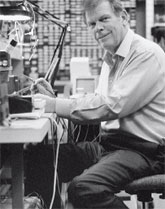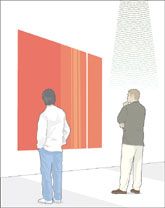The Sound War
Focused beams of sound could direct music or speech to a single person in a crowd. Two inventors have staked competing claims to a potential audio revolution.
Elwood “Woody” Norris. Company: American Technology Corporation. Invention: Hypersonic Sound. Motivation: Replace the ubiquitous loudspeaker. Vision: Sound that can be beamed to individual listeners. (Photo by Bryce Duffy)
By Evan I. Schwartz
History is replete with rival inventors battling one another to bring breakthrough creations to market: Howe and Singer over the sewing machine, Bell and Gray over the telephone, Edison and Swan over the light bulb. In many cases, the winner went on to become a household name and captain of industry, while the loser was essentially forgotten.
Now, in that same tradition, two inventors are each staking claim to a new audio technology that corporate customers say will have a huge market within the next five years. Known as directional sound, it uses an ultrasound emitter to shoot a laserlike beam of audible sound so focused that only people inside a narrow path can hear it. “It’s phenomenal,” says Simon Beesley, an audio marketing manager for Sony’s European business division. So far Sony has sold just a handful of directional-sound systems for specialty installations in stores and other locations, but ultimately, says Beesley, “Without question, this is going to be a billion-dollar-plus product.”
But who will claim that billion-dollar prize? Elwood “Woody” Norris, of Poway, CA-based American Technology Corporation (ATC), and F. Joseph Pompei, of Watertown, MA’s Holosonic Research Labs, have harnessed the same scientific principle to create competing directional-sound systems, and each insists his version will transform acoustics. Norris and Pompei both envision a family of four sitting in a car enjoying four different musical selections or radio broadcasts at once—with no headphones. They also see street-level billboards or displays in retail locations that speak only to one passing consumer at a time, or a crowded trade show in which the cacophony of thousands of product demonstrations is replaced by thousands of focused beams of sound confined to their own exhibits. Rather than using a megaphone, a police officer could control crowds by directing his or her voice only at a person creating a disturbance. The ultimate goal, say both inventors, is to replace a large number of the millions of loudspeakers sold each year for home entertainment and personal-computer systems with directional-sound devices.
They may share a vision, but these dueling inventors could hardly be more different. Woody Norris is a 65-year-old West Coast maverick with no college degree who got most of his formal education during a stint as a radar technician in the U.S. Air Force more than 40 years ago. The holder of a once valuable but long-expired patent on diagnostic ultrasound, the self-taught inventor has made a personal fortune that he estimates is in the tens of millions of dollars by inventing audio devices, including a hearing-aid-sized FM radio, a line of flash-memory voice recorders and car audio systems, and several models of cell-phone headsets. He has been at work on what he calls “hypersonic sound” for much of the past decade and claims to have invested $40 million in its development. “He has an intuitive understanding of physics and electronics,” says Curt Edgar, senior manager for advanced technology at DaimlerChrysler, who has met with Norris for demonstrations. “He’s also got incredible persistence.”
In sharp contrast, Joe Pompei is a 30-year-old East Coast entrepreneur with impressive educational credentials but little track record as an inventor: his Audio Spotlight system is his first major invention. In high school and during breaks from college, while working part time for Bose, the Framingham, MA, loudspeaker manufacturer, Pompei took note of the limitations of traditional speakers. But, he says, executives at Bose “were not interested in hearing about the future of sound from a 20-year-old.” After receiving his electrical engineering degree from Rensselaer Polytechnic Institute, he went on to get his master’s in psychoacoustics at Northwestern University. He says it was there, in the mid-1990s, that he got the idea for using silent ultrasound as a way of producing audible sound. “I was considered a mad scientist,” Pompei recalls.
He first demonstrated the basic principle at the MIT Media Laboratory. While completing his PhD at MIT in 2002, Pompei launched Holosonic, bootstrapping the company with just a few thousand dollars of his own research stipend money. Pompei’s system “really does behave like a spotlight,” says David Rabkin, vice president of technology at Boston’s Museum of Science, which uses the system in an exhibit. “You point the beam at one person and light them up with sound. But once you step outside the beam, the sound drops off quickly.”
The technologies and the visions of the inventors are strikingly similar. So it’s likely that the differences in their personalities, backgrounds, and business tactics will be critical factors in deciding who is the first to overcome the roadblocks—including high costs, lack of mass-production standards, and performance kinks—that stand between them and the lucrative markets they both envision. Which one of them prevails, if either, will speak volumes about the relative value of education and experience, youth and wisdom—and perhaps luck and timing—in ensuring an inventor’s place in history.
Hearing Things
One thing Pompei and Norris have in common is this: each quickly learned that in chasing directional sound he was heading down a path others had trod before. Norris says he first got the idea for what has become his Hypersonic Sound system in the late 1970s. He had recently raised money by selling stock in one of his startups and, flush with cash, was eagerly looking for his next big thing. “I was ignorant and naïve enough to think I was the first person to think of this,” he says. But as he researched old patents and publications, “names came out of the wall. People have been trying this for fifty years.” Pompei’s own research revealed that major Japanese corporations had looked into the concept in the early 1980s but abandoned their quest, suspecting that the technique would produce distorted sound or require too much power to be of any use.
Both Norris and Pompei believe they have solved most of the problems that stymied their predecessors. Each of their systems contains a signal processor, an amplifier, and a platelike device that shoots out beams of ultrasound. At his suburban San Diego laboratory, Norris plugs his Hypersonic Sound emitter into an ordinary portable CD player for a demonstration outside in the parking lot. When he points the device at a visitor standing about 20 meters away, the visitor is able to clearly hear sounds ranging from a waterfall to jazz music. But when Norris points the emitter to the left or right or up to the sky, the visitor hears no sound at all. Inside the lab’s conference room, Norris directs the emitter at walls, bouncing the sound beams so that they seem to be coming from spots on the wall, rather than from the device itself.
It’s easy to see why directional sound is cool, but understanding how it works is far tougher. Traditional speakers generate audible sound waves that spread out in all directions like ripples from a pebble tossed in a pond. Norris’s and Pompei’s devices instead generate narrow, laserlike beams of ultrasound waves, which have a frequency above 20,000 hertz, the upper limit of what the human ear can detect. Both audible sound waves from traditional speakers and ultrasound waves from a directional-sound system distort when they travel through the air; in a traditional sound system, the distortion slightly degrades the sound a listener ultimately hears. But in a directional-sound system, the distortion is actually the mechanism that generates the audible sound, breaking the ultrasound waves into lower-frequency, audible sound waves along a straight, narrow path.
Sound and silence: Directional-sound systems could create discrete zones of sound in otherwise silent locations. Here, one museumgoer learns about a painting by listening to a beamed-in commentary while another chooses quiet contemplation instead. (+ISM)
Pumping Up the Volume
The paths of the two inventors, on the other hand, are converging on a marketplace battlefield where corporate customers will be won and lost. The clash is already fierce. Pompei, for instance, says that his is the only directional-sound system that has been built into a vehicle from a major manufacturer.
In fact, three years ago, when the Audio Spotlight was part of a project at the MIT Media Lab, research sponsor DaimlerChrysler did indeed incorporate a prototype into a concept car, with transducers located above each of the four seats in the cabin. “Functionally, it worked,” says Daimler’s Edgar. But there was one main glitch: the beams would bounce off of the seats and other surfaces, deflecting sound between the zones. Because of that drawback, and the high cost of the system, the automaker didn’t pursue it further. Instead, a year ago, Edgar got in touch with Norris. “ATC has made more strides, in terms of cost and manufacturing and performance,” says Edgar. “They are a couple generations beyond where Holosonic was.” Still, Norris’s system has yet to be built into a vehicle, and there are no immediate plans at Daimler to do so.
Norris admits that he is working on improving the performance of his Hypersonic Sound system. One issue is the technology’s current inability to produce low bass tones, a shortcoming that Pompei’s system shares. But Norris says that Sony is already rolling out the product in Europe. Sony’s Beesley confirms that the company has to date distributed hundreds of Hypersonic Sound systems, which it integrates with its plasma video screens for specialty applications. He says that department stores, banks, and museum exhibitors are using the technology to beam sound at customers and visitors in particular areas. “It has huge potential,” Beesley says. The main limitation of the system, he adds, is its price. “It’s pretty much hand-built right now,” he says, at a cost of about $1,000 per unit. “We’re looking at various industrial designs to make it cheaper and easier to produce.” The goal is a price point of less than $100 per installation. Daimler’s Edgar says a similar price point is essential to making directional-sound technology competitive with traditional car-stereo speakers.
At $1,000 to $2,000 per system, Pompei’s Audio Spotlight suffers from the same high-cost, low-production-quantity syndrome. Early customers such as Steelcase, which is testing it for office environments, and Cisco, which has installed it in corporate lobbies, have only purchased a few units each.
As ATC and Holosonic race to transform their systems from high-end curiosities to household staples, Norris says he is relying on his patents to protect his intellectual property in the marketplace. On that front, he appears to have the edge on Pompei. Norris has about 20 issued patents covering various aspects of directional-sound technology, and he says that 20 additional ones are pending. Pompei says he has about a dozen patents pending, including two key ones, but only one that has been issued so far.
Given the similarity in the technologies and visions of Pompei and Norris, the shouting match is likely to get louder. The one thing the two inventors can agree on is that directional sound has real long-term opportunities, especially when it comes to displacing the ubiquitous loudspeaker, invented more than 80 years ago. Even the best loudspeakers, they agree, are subject to distortion, and their omnidirectional sound is annoying to people in the vicinity who don’t wish to listen. What remains to be seen is which, if either, of these two inventors will become the Alexander Graham Bell of directional sound, and which will become the Elisha Gray.
Evan I. Schwartz is a Technology Review contributing writer and the author of Juice: The Creative Fuel Driving Today’s World-Class Inventors, forthcoming in September.
Copyright 2004 Technology Review, Inc. All rights reserved

